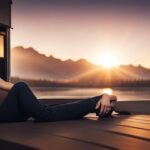Beginners Guides
What Are The Tiny Flies In My House
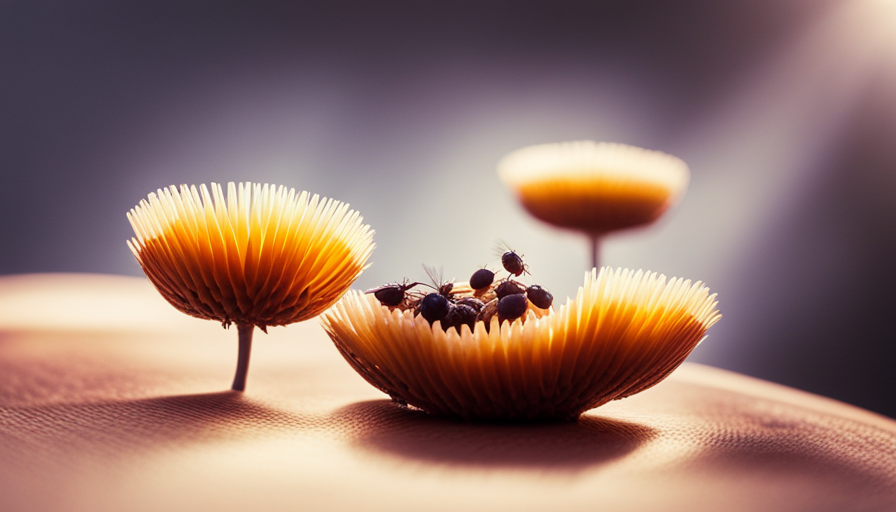
Chilling in my comfy living room, tiny flies catch my eye, zooming around. Sure, they look harmless, but boy, are they a nuisance. It gets me thinking, what are these annoying visitors, and why have they picked my home for their playground?
To satisfy my curiosity, I delved into the world of entomology to uncover the secrets of these tiny flies. Understanding the type of fly is crucial in order to effectively deal with them. By examining their life cycle, we can gain valuable insights into their behavior and habits. From fruit flies to drain flies, there are various types of tiny flies that can infest our homes. But what attracts them to our living spaces in the first place?
Beyond the annoyance factor, these tiny flies can pose health risks. They can carry disease-causing pathogens and contaminate our food and surfaces. Therefore, it becomes crucial to implement prevention and control methods to keep them at bay.
In this article, we will explore the common types of tiny flies found in houses, the reasons behind their presence, the health risks they pose, and effective prevention and control methods. Furthermore, we will delve into natural remedies and chemical solutions to eliminate them. If all else fails, we will also discuss the option of hiring professional pest control services.
So, let’s embark on this entomological journey together and bid farewell to these tiny flies once and for all.
Key Takeaways
- Identifying the type of fly is important for effective elimination.
- Different types of flies are attracted to different environments and attractants.
- Tiny flies can carry disease-causing pathogens and contaminate food and surfaces.
- Proper sanitation, elimination of breeding sites, and use of fly traps or insecticides can reduce the population of tiny flies and minimize health risks.
Identify the Type of Fly
If you’re wondering what those tiny flies in your house are, it’s important to identify the type of fly so that you can effectively get rid of them. Identifying the breeding grounds is a crucial step in this process. Different types of flies are attracted to different environments, so understanding where they breed can help you eliminate their food and breeding sources.
For example, fruit flies are often found near overripe fruits and vegetables, while drain flies thrive in moist areas like drains and pipes. By locating these breeding grounds, you can take targeted action to eliminate them.
In addition to breeding grounds, it’s also important to be aware of the attractants for different types of flies. Flies are attracted to a variety of substances such as decaying organic matter, garbage, and even certain plants. By removing or properly managing these attractants, you can reduce the likelihood of flies infesting your home.
Understanding the life cycle of these tiny flies is the next step in effectively getting rid of them. By knowing how they develop from eggs to larvae to adults, you can implement control methods at the right times.
But before we delve into their life cycle, let’s first explore the different types of flies commonly found in households.
Understanding their Life Cycle
Understanding the life cycle of these pests can help in effectively managing their population. Tiny flies in the house, such as fruit flies and drain flies, have distinct life cycles that contribute to their presence.
Fruit flies, for instance, go through four stages: egg, larva, pupa, and adult. The eggs are typically laid near fermenting fruits and vegetables, and the larvae feed on the decaying matter. After the pupal stage, the adult flies emerge and start the cycle again.
Drain flies, on the other hand, undergo a similar life cycle but lay their eggs in moist organic matter found in drains and pipes. Understanding their behavior is crucial in controlling their population.
Keeping the house clean and disposing of ripe or rotting fruits can help prevent fruit fly infestations. Regularly cleaning drains and removing any standing water can deter drain flies. Additionally, there are effective home remedies such as apple cider vinegar traps for fruit flies and bleach solutions for drain flies.
By understanding their life cycle and implementing these measures, we can effectively manage the population of these tiny flies in our homes.
Transitioning to the next section, let’s explore the common types of tiny flies found in houses.
Common Types of Tiny Flies Found in Houses
To effectively manage the population of these pests, you should familiarize yourself with the common types of small flies commonly found in households.
One of the most common types is the fruit fly, attracted to ripe and rotting fruits and vegetables. They can enter your house through open windows or doors and breed quickly, making it essential to dispose of any overripe produce.
Another common type is the drain fly, which thrives in damp areas like drains and sewers. They are attracted to decaying organic matter, so keeping your drains clean and dry is crucial in preventing their infestation.
Additionally, fungus gnats are attracted to moist soil, particularly in potted plants. To prevent them from entering your house, avoid overwatering your plants and ensure proper drainage.
Finally, phorid flies are often found in decaying organic matter, such as garbage and dead animals. Proper waste management and regular cleaning are essential in keeping them at bay.
Understanding the types of food tiny flies are attracted to and taking preventative measures can significantly reduce their presence in your house.
Moving on to the next section, let’s explore the reasons why they are in your house.
Reasons Why They Are in Your House
Wondering why these pesky insects have invaded your home? Let’s uncover the reasons they’ve made themselves at home in your house. Tiny flies are attracted to specific conditions that are conducive to their survival and reproduction. Here are some reasons why they may have found their way into your living space:
-
Moisture: Flies are attracted to moist environments, such as leaky pipes, damp basements, or standing water. Eliminating these sources of moisture can help reduce their presence.
-
Food sources: These flies are drawn to organic matter, including decaying fruits and vegetables, spilled liquids, or even pet food left out. Properly storing food and promptly cleaning up spills can deter their attraction.
-
Garbage: Flies are notorious for breeding in garbage bins or compost piles. Ensuring that your garbage is tightly sealed and regularly emptied can help prevent their infestation.
-
Plants: Certain species of tiny flies are attracted to plants and soil. Overwatering plants can create a breeding ground for these insects, so it’s essential to water them appropriately.
-
Unattended areas: Neglected spaces, such as unused drains, forgotten mops, or neglected cleaning tools, can become ideal breeding grounds for tiny flies. Regular cleaning and maintenance can help remove these potential habitats.
By addressing these factors and removing the breeding grounds, you can significantly reduce the presence of tiny flies in your house.
Now let’s explore the health risks associated with these bothersome insects.
Health Risks Associated with Tiny Flies
Now, let’s delve into the potential health hazards linked to these pesky little insects. While tiny flies may seem harmless, they can actually pose some serious health risks when present in large numbers.
One of the main concerns with small fly infestations is the transmission of diseases. These flies are known to carry pathogens such as bacteria, viruses, and parasites, which can contaminate food, surfaces, and even the air we breathe. This puts us at risk of developing various illnesses, including food poisoning, diarrhea, respiratory infections, and skin infections.
Furthermore, the presence of tiny flies in homes can also trigger allergic reactions in some individuals. Their saliva, feces, and body parts can act as allergens, leading to symptoms like sneezing, coughing, wheezing, and skin rashes. Those with pre-existing respiratory conditions, such as asthma, may experience exacerbations due to the increased airborne allergens.
To prevent the health concerns associated with tiny flies in homes, it’s important to implement effective prevention and control methods. By maintaining proper sanitation, eliminating potential breeding sites, and using fly traps or insecticides, we can significantly reduce the population of these insects and minimize the health risks they pose.
Transitioning into the subsequent section, let’s now explore the different prevention and control methods available to tackle these pesky little flies.
Prevention and Control Methods
Implementing effective prevention and control methods is crucial in reducing the population of these pesky insects and minimizing the potential health risks they pose in our homes. To tackle a fly infestation, maintaining home cleanliness is key. Flies are attracted to food sources, so it’s important to keep all surfaces, especially kitchen countertops and dining areas, clean and free from crumbs and spills.
Regularly emptying and cleaning trash cans, as well as sealing any potential entry points, such as cracks in windows or doors, can help prevent flies from entering the house.
In addition to cleanliness, proper storage of food is essential in fly prevention. Keep all food items, especially fruits and vegetables, in sealed containers or in the refrigerator. Make sure to discard any overripe or rotting produce promptly, as this can attract flies.
To transition into the subsequent section about natural remedies for getting rid of tiny flies, it’s important to note that while prevention and cleanliness are effective in reducing fly populations, sometimes additional measures are needed.
In the next section, we’ll explore natural remedies that can be used to effectively eliminate these pesky insects from your home.
Natural Remedies for Getting Rid of Tiny Flies
When it comes to getting rid of tiny flies in my house, I’ve found that vinegar traps are an effective natural remedy. I place a mixture of vinegar and dish soap in a container, and the flies are attracted to the scent and then trapped in the solution.
Another natural remedy that I find useful is using essential oils. I mix certain oils, like lavender or eucalyptus, with water and spray them around areas where the flies are present. This acts as a repellent.
Lastly, fly swatters and traps are always handy to have around. These simple tools allow me to physically remove or catch the flies, helping to control their population.
Vinegar Traps
Using vinegar traps can be an effective way to catch and eliminate tiny flies in your house, such as fruit flies or fungus gnats. For instance, a homeowner in California successfully used vinegar traps to significantly reduce the population of fruit flies in their kitchen within a week.
-
Vinegar benefits: Vinegar has a strong odor that attracts flies, making it an excellent bait for traps. Additionally, it contains acetic acid which can kill the flies upon contact.
-
Alternative traps: Apart from vinegar, you can also use other household items to create effective traps. For example, a combination of dish soap and apple cider vinegar can be used to drown the flies. Alternatively, you can create a trap using a plastic bottle by cutting off the top, inverting it, and placing a vinegar-soaked fruit inside.
By using vinegar traps, you can quickly and efficiently reduce the population of tiny flies in your house. However, if you prefer alternative methods, the next section will explore how essential oils can help combat these pesky insects.
Essential Oils
Now let’s dive into the world of essential oils and how they can come to the rescue in the battle against those pesky little critters. Essential oils have long been used as natural remedies for various ailments, and they can also be effective in repelling and eliminating tiny flies in your house.
Certain essential oils, such as lavender, peppermint, and eucalyptus, have strong scents that flies find unpleasant and will often avoid. To create a homemade fly repellent, mix a few drops of your chosen essential oil with water in a spray bottle and lightly mist areas where flies are present. Additionally, you can soak cotton balls in the essential oil and place them near windows and doors to deter flies from entering.
These natural remedies can be a great alternative to chemical-based sprays and can help keep those tiny flies at bay. Moving on to fly swatters and traps, let’s explore some other effective methods for getting rid of these pesky insects.
Fly Swatters and Traps
To truly triumph over those pesky little intruders, equip yourself with a trusty fly swatter or deploy clever traps. Fly swatters are a simple and effective way to eliminate flies. With a quick flick of the wrist, you can swiftly put an end to their buzzing presence.
There are also various types of traps available that can capture and eliminate flies. One popular option is homemade fly traps, which can be made using ingredients like vinegar, sugar, and dish soap. These traps attract flies with their enticing scent, and once the flies enter, they become trapped and unable to escape.
Another effective method is using fly repellents, which can be sprayed in areas where flies are commonly found. These repellents work by emitting odors that flies find unpleasant, deterring them from entering your home.
Using these methods, you can significantly reduce the number of flies in your house and enjoy a fly-free environment.
Transitioning into the subsequent section about ‘chemical solutions for eliminating tiny flies,’ there are additional steps you can take to eradicate these pests completely.
Chemical Solutions for Eliminating Tiny Flies
If you’re dealing with tiny flies in your house, there are effective chemical solutions available that can help eliminate them. While natural alternatives and homemade fly repellents can be helpful, sometimes the situation calls for stronger measures.
Chemical solutions provide a targeted approach to eradicate these pesky insects. One option is to use an insecticide spray specifically designed for flying insects. These sprays contain chemicals that act as neurotoxins, affecting the nervous system of the flies upon contact. They can be applied directly to the flies or to surfaces where the flies are likely to land. It’s important to read and follow the instructions carefully to ensure safe and effective use.
Another effective chemical solution is fly bait. These products contain attractants that lure the flies, and once ingested, the chemicals in the bait cause the flies to die. Fly baits can be placed in traps or scattered in areas where the flies are frequently seen.
When using chemical solutions, it’s crucial to prioritize safety. Keep the products out of reach of children and pets, and follow all safety precautions mentioned on the packaging.
If chemical solutions do not provide the desired results, or if the infestation becomes overwhelming, it may be necessary to consider hiring professional pest control services. These experts have the knowledge and expertise to identify the source of the problem and provide effective solutions to eliminate the flies.
While natural alternatives and homemade fly repellents can be helpful, chemical solutions offer a targeted and effective approach to eliminate tiny flies in your house. However, if these methods prove ineffective, it may be time to consider professional pest control services.
Hiring Professional Pest Control Services
Hiring professional pest control services is like calling in the cavalry to wage war against an army of persistent and pesky insect invaders. When dealing with tiny flies in your house, it’s important to consider the effectiveness of DIY fly control methods.
While there are numerous products available in the market, they may not provide long-lasting results. Professional pest control services, on the other hand, have the expertise and knowledge to tackle the issue effectively.
One key advantage of hiring professionals is the thoroughness of their pest inspections. They will not only identify the source of the problem but also assess the extent of the infestation. This step is crucial in developing a customized treatment plan that targets the specific type of flies invading your home.
Professional pest control services also have access to a wide range of products and treatments that are not available to the general public. These products are often more potent and effective in eliminating the flies and preventing their return. Additionally, professionals have the necessary equipment to apply these treatments safely and efficiently, ensuring the well-being of your household.
Regular pest inspections are also essential in preventing future infestations. Professionals can identify potential entry points and advise on ways to seal them off, minimizing the chances of flies entering your home.
When it comes to dealing with tiny flies in your house, hiring professional pest control services is a wise choice. Their expertise, access to specialized products, and commitment to regular inspections can help eliminate the flies and prevent future invasions.
Frequently Asked Questions
How do I differentiate between fruit flies and drain flies?
To differentiate between fruit flies and drain flies, observe their appearance and behavior. Fruit flies are attracted to ripe fruits and vegetables, while drain flies prefer moist areas like drains. Signs of a fly infestation include numerous flies and their larvae in the affected area.
Are there any specific times of the year when tiny flies are more likely to invade homes?
Specific times of the year when tiny flies are more likely to invade homes vary depending on the species. For fruit flies, they are common in warmer months, while drain flies thrive in moist conditions year-round.
Can tiny flies cause damage to my property?
Tiny flies can cause damage to property if they lay eggs in moist areas, leading to infestations. Additionally, their presence can contaminate food and surfaces, posing health risks. Proper sanitation and elimination of breeding sites are crucial to prevent these potential dangers.
How can I prevent tiny flies from entering my house in the first place?
To prevent fly infestation and keep those pesky bugs out of my house, I’ll share my secret weapon: natural fly repellents. These powerful potions will make flies flee like they’ve seen a flying elephant!
Are there any natural remedies that can effectively eliminate tiny flies without using chemicals?
There are several natural remedies and chemical-free solutions that can effectively eliminate tiny flies. These include using apple cider vinegar traps, creating fly-repellent herbs or essential oil sprays, and maintaining a clean and dry environment to discourage their presence.
Conclusion
In conclusion, identifying and understanding the life cycle of the tiny flies in your house is crucial in order to effectively prevent and control their presence.
Common types of these flies include fruit flies, drain flies, and fungus gnats, each with their own unique characteristics and behavior.
While these flies may seem harmless, they can pose health risks and contaminate food.
Natural remedies, such as vinegar traps and proper sanitation, can help eliminate them, while chemical solutions and professional pest control services offer more aggressive options.
By taking the necessary steps, you can ensure a fly-free home and a healthier environment.
Hi, I’m Emma. I’m the Editor in Chief of Tiny House 43, a blog all about tiny houses. While tree houses are often associated with childhood, they can be the perfect adult retreat. They offer a cozy space to relax and unwind, surrounded by nature. And since they’re typically built on stilts or raised platforms, they offer stunning views that traditional homes simply can’t match. If you’re looking for a unique and romantic getaway, a tree house tiny house might just be the perfect option.
Beginners Guides
How Do I Get Rid of Tiny White Bugs on My House Plants

- Health risks associated with tiny white bugs on house plants.
- Effective methods to prevent infestations of tiny white bugs on house plants
I am facing a small white insect issue with my indoor plants, and it is really frustrating me! These annoying bugs seem to be multiplying quickly, causing damage to my precious plants.
But fear not, my fellow plant enthusiasts, for I’ve done my research and found some effective solutions to eliminate these unwelcome guests.
In this article, I’ll share with you the knowledge and remedies I’ve discovered, so you too can reclaim your bug-free, thriving indoor garden.
Key Takeaways
- Aphids, mealybugs, and whiteflies are common types of tiny white bugs found on house plants.
- Lack of proper plant care, overwatering, and bringing infested plants indoors can lead to bug infestations.
- Homemade insecticides using water and dish soap or neem oil can suffocate and disrupt the feeding patterns of pests.
- Regular cleaning and inspection routines help detect and address pest issues early on.
Identifying the Tiny White Bugs on Your House Plants
I can easily spot the tiny white bugs on my house plants by carefully examining the leaves and stems. The most common species of these pests found on house plants are aphids, mealybugs, and whiteflies.

Aphids are small, pear-shaped insects that cluster on new leaves and buds.
Mealybugs are covered in a white, waxy substance and can be found on the undersides of leaves and in leaf axils.
Whiteflies, as the name suggests, are tiny white insects that fly around when disturbed.
An infestation of these tiny white bugs can cause significant damage to your house plants. Signs of infestation include yellowing leaves, stunted growth, distorted foliage, and a sticky residue called honeydew on the leaves. Furthermore, these pests can transmit plant diseases, weaken the plant’s immune system, and attract other pests.

Understanding the causes of infestation is crucial in effectively getting rid of these tiny white bugs on your house plants.
Understanding the Causes of Infestation
Understanding the causes of infestation is essential in effectively eliminating these tiny white bugs on my house plants. Here are a few key factors to consider:
- Lack of proper plant care: Neglecting to provide adequate water, sunlight, and nutrients can weaken plants, making them more susceptible to bug infestations.
- Overwatering: Excessive moisture can create a favorable environment for pests like aphids and mealybugs.
- Bringing infested plants indoors: Introducing plants from outside without proper inspection can bring unwanted bugs into your home.
Recognizing the signs of bug damage is crucial for preventing infestation. Look out for yellowing, wilting leaves, sticky residue on leaves and stems, and tiny white bugs crawling on the plant’s surface.
Now that we understand the causes of infestation, let’s explore natural remedies to eliminate these pesky bugs.

Natural Remedies to Eliminate the Bugs
To effectively get rid of these tiny white bugs on my house plants, I’ll need to rely on natural remedies that can eliminate them without harming the plants.
One effective option is to create homemade insecticides using ingredients readily available in your kitchen. You can mix a solution of water and dish soap, or water and neem oil, and spray it directly on the affected plants. These solutions work by suffocating the pests and disrupting their feeding patterns.
Another natural approach is to introduce insect-repelling plants into your garden. Plants like lavender, mint, and marigold emit fragrances that repel insects, keeping them away from your precious plants.
Chemical Solutions for a Lasting Bug-Free Environment
One effective chemical solution for achieving a bug-free environment is using a professional-grade insecticide spray. These sprays are specifically formulated to target and eliminate pests, including tiny white bugs on house plants. When using a professional-grade insecticide spray, it’s important to follow the instructions provided by the manufacturer to ensure safe and effective use.

Additionally, consider these non-toxic alternatives to chemical solutions for pest control:
-
Neem oil: Derived from the neem tree, neem oil is a natural insecticide that can be effective against a wide range of pests. It works by disrupting the insect’s life cycle and repelling them from plants.
-
Insecticidal soap: Made from potassium salts of fatty acids, insecticidal soap works by suffocating pests on contact. It’s safe to use on most plants and can be an effective solution against white bugs.
-
Diatomaceous earth: This powdery substance is made from fossilized remains of diatoms and acts as a desiccant, drying out and killing insects.

When using any chemical solution or non-toxic alternative, it’s essential to monitor the plants closely and repeat the treatment as necessary to maintain a bug-free environment. Professional pest control services can also provide expert guidance and assistance in achieving long-lasting results.
Preventing Future Infestations and Maintaining Healthy House Plants
To effectively prevent future infestations and maintain healthy house plants, I will implement a regular cleaning and inspection routine. This will help ensure that any signs of pests or diseases are detected early on and addressed promptly. Regularly cleaning the leaves and stems of my plants with a mild soap and water solution will help remove any dust or debris that can attract pests. Additionally, I will inspect the plants for any signs of infestation, such as white bugs or sticky residue on the leaves. To further enhance plant hygiene, I will also consider using beneficial insects, such as ladybugs or lacewings, which feed on common plant pests like aphids. By incorporating these practices into my routine, I can maintain healthy house plants and prevent future infestations.
| Regular Cleaning | Inspection Routine | Using Beneficial Insects |
| Remove dust and debris | Check for signs of infestation | Introduce ladybugs or lacewings to control pests |
| Promotes plant hygiene | Detect and address issues early | Natural pest control method |
| Prevents pest attraction | Maintain healthy house plants | Encourages ecosystem balance |
Frequently Asked Questions
Can These Tiny White Bugs Harm Humans?
Yes, tiny white bugs on house plants can harm humans. They can cause skin irritations and allergic reactions. It’s important to take steps to prevent infestations, such as regularly inspecting and cleaning your plants.
How Long Does It Take for Natural Remedies to Eliminate the Bugs Completely?
To completely eliminate the tiny white bugs using natural remedies, it typically takes a few weeks of consistent application. However, the effectiveness of these remedies can vary. It’s important to avoid common mistakes like under-applying or using incorrect remedies.

Are There Any Specific Types of House Plants That Are More Prone to Infestations?
Certain house plants, like lavender and marigolds, have natural repellent properties that can help prevent infestations. It’s important to choose plants that are known to repel bugs and to regularly inspect and clean your plants to avoid any potential infestations.
Can These Bugs Spread From One House Plant to Another?
Oh, the joy of tiny white bugs on house plants! Yes, these pests can spread from one plant to another. To control them, use insecticides and watch out for signs of infestation like sticky residue or wilting leaves.
How Often Should I Check My House Plants for Signs of Infestation?
I check my house plants for signs of infestation regularly to ensure their health. Common signs include tiny white bugs and yellowing leaves. Preventative measures like proper watering and cleaning can help keep plants bug-free.
Conclusion
In conclusion, taking care of our house plants goes beyond watering and sunlight. Identifying and eliminating tiny white bugs is a crucial part of maintaining a healthy environment for our plants.

By understanding the causes of infestation and using natural or chemical remedies, we can ensure a bug-free environment. Remember, prevention is key, so regularly inspect your plants and take necessary measures to keep them thriving.
Happy gardening!
I’m Theodore, and I love tiny houses. In fact, I’m the author of Tiny House 43, a book about tiny houses that are also tree houses. I think they’re magical places where imaginations can run wild and adventures are just waiting to happen.
While tree houses are often associated with childhood, they can be the perfect adult retreat. They offer a cozy space to relax and unwind, surrounded by nature. And since they’re typically built on stilts or raised platforms, they offer stunning views that traditional homes simply can’t match.
If you’re looking for a unique and romantic getaway, a tree house tiny house might just be the perfect option.
Beginners Guides
How Do I Get Rid of Tiny Moths in My House

I have experienced the frustration of dealing with tiny moths flying around my food in the kitchen. But do not worry, I have a solution for you.
In this article, I’ll show you how to banish those pesky moths from your house for good. We’ll dive into identifying different moth species, understanding what attracts them, and simple prevention techniques you can implement.
Plus, I’ll share some natural remedies and professional options as a last resort. Say goodbye to those unwanted guests!
Key Takeaways
- Identifying the specific moth species is crucial for implementing targeted control measures.
- Moths are attracted to food sources, fabrics, and organic materials, so it’s important to store food in airtight containers and keep the house clean.
- Moths prefer dark, undisturbed areas to lay their eggs, so sealing cracks and openings in walls, windows, and doors can help prevent infestation.
- If natural remedies and DIY methods fail, it is advisable to seek professional pest control services for thorough inspection and tailored treatment plans.
Identifying the Culprits: What Type of Moth Is Invading Your Home
I can’t figure out what kind of moth is infesting my home. It’s frustrating not knowing the exact species, as different moths have different behaviors and habits. Identifying the culprits is crucial in order to effectively address the problem.

There are several common moth species that are known to invade homes, such as the Indian mealmoth, clothes moth, and pantry moth. Each species has distinct characteristics that can help with identification. Understanding their behavior is also important as it can give insights into their lifecycle and potential sources of infestation.
Moths are attracted to food sources, fabrics, and other organic materials. They can lay eggs in stored grains, textiles, or even pet food. By understanding the specific species and their behavior, it becomes easier to implement targeted control measures and prevent further infestations.
Understanding the Infestation: Why Are Moths Attracted to Your House
To effectively address the infestation, it’s essential to understand why moths are attracted to your house. Here are four reasons why moths may be flocking to your home:
-
Food sources: Moths are attracted to food, especially grains, cereals, and dried fruits. They can easily find their way into your pantry and feast on these items.

-
Moisture and humidity: Moths thrive in damp environments, making your house an ideal breeding ground if there are areas with high humidity or water leaks.
-
Suitable habitat: Moths are drawn to dark, undisturbed areas where they can lay their eggs undisturbed. This includes closets, attics, and basements.
-
Outdoor attraction: Moths can be attracted to your house from the outside, especially if you have outdoor lights that are left on at night.
Understanding moth behavior and their attraction to your house is crucial in preventing further infestation. By addressing these factors, you can take steps to keep moths at bay and protect your home.

Here are some moth prevention tips:
- Store food in airtight containers.
- Keep your house clean and free of crumbs or spills.
- Fix any leaks or moisture issues promptly.
- Use moth repellents or traps in vulnerable areas.
Prevention Is Key: Simple Steps to Keep Moths From Entering Your Home
Prevention is essential, so I’ll share some simple steps to keep moths from entering your home. By taking a proactive approach, you can create an inhospitable environment for moths and minimize the risk of infestations. One effective method is to use moth repellent products, such as sachets or sprays, in areas where moths are commonly found. These repellents contain chemicals that deter moths from entering your home. Additionally, it is crucial to seal any cracks or openings in your walls, windows, and doors. Moths can easily slip through these tiny gaps, so using caulk or weatherstripping can help keep them out. Regularly vacuuming and cleaning your home can also eliminate moth eggs or larvae that may be hiding in carpets or corners. By implementing these preventive measures, you can ensure a moth-free home environment.
| Steps to Keep Moths Away | |
|---|---|
| Use moth repellent products | Seal cracks and openings |
| Regularly vacuum and clean |
Natural Remedies: Non-Toxic Solutions to Get Rid of Moths
One effective way to get rid of moths naturally is by using a combination of vinegar and water to create a non-toxic moth spray. Here are some natural remedies you can try:
-
Vinegar and water spray: Mix equal parts vinegar and water in a spray bottle. Spray this solution on areas where moths are present, such as closets, drawers, and pantry shelves. The strong odor of vinegar repels moths and prevents them from laying eggs.
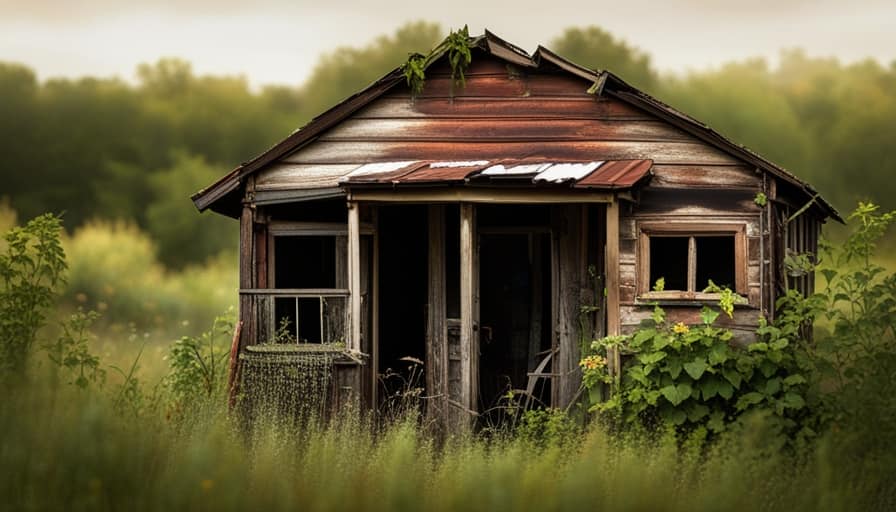
-
Cedar chips: Moths dislike the smell of cedar, so placing cedar chips in your closets and drawers can help deter them. You can also use cedar oil or cedar sachets for the same effect.
-
Homemade traps: Create simple moth traps by placing a mixture of vinegar, sugar, and dish soap in a bowl. The sweet scent attracts moths, and the dish soap traps them when they try to land on the mixture.
-
Lavender sachets: Moths are repelled by the fragrance of lavender. Place dried lavender in small sachets and tuck them in your clothing drawers or hang them in your closets.
These natural repellents and homemade traps can help you get rid of moths without using toxic chemicals. However, if these methods fail to eliminate the infestation, it may be time to consider professional pest control options.

Last Resort: When All Else Fails, Professional Pest Control Options
If I’ve exhausted all other options, I’ll contact a professional pest control service to eliminate the moth infestation in my house. While natural remedies and DIY methods can be effective for small infestations, sometimes the problem persists or worsens despite our best efforts.
This is when it’s crucial to call in the experts. Professional pest control services have the knowledge, experience, and resources to effectively eradicate moth infestations. They’ll conduct a thorough inspection of your home to identify the source of the infestation and develop a tailored treatment plan.
The benefits of hiring professionals include their expertise in identifying different moth species, their access to specialized equipment and pesticides, and their ability to ensure the complete eradication of the infestation.
When all else fails, it’s best to rely on the expertise of professional pest control services to rid your home of those persistent moths.

Frequently Asked Questions
Can Moths Cause Any Damage to My House or Belongings?
Moths can cause damage to fabrics, carpets, and stored food. It’s important to address a moth infestation promptly. Using natural moth repellents, like lavender or cedar, can help deter them from your house and protect your belongings.
Are All Types of Moths Attracted to Homes, or Are There Specific Species That Are More Common?
In the world of moths, certain species have a penchant for our cozy homes. Understanding the types commonly found indoors can help us prevent the dreaded infestations from taking hold in the first place.
How Long Does It Usually Take to Get Rid of a Moth Infestation Using Natural Remedies?
Using natural remedies to get rid of a moth infestation can be effective, but the time it takes varies depending on the severity. Common signs of an infestation include sightings of adult moths and larvae, as well as damaged fabrics or food products.
Can Moths Carry Diseases or Pose a Health Risk to Humans?
Moths can transmit diseases to humans, so it’s important to take precautions. Individuals with allergies or asthma may experience respiratory issues due to moth infestations in homes.

Are There Any Specific Plants or Herbs That Repel Moths and Can Be Used as Natural Remedies?
Using natural moth repellents, such as specific plants and herbs, offers several benefits over chemical alternatives. Creating a moth repelling garden with lavender, rosemary, and mint can effectively deter moths from your house.
Conclusion
In conclusion, it’s essential to address the presence of these minuscule pests in your home promptly. By identifying the specific type of moth invading your space and understanding their attraction, you can take preventive measures to keep them at bay.
Utilizing natural remedies and seeking professional pest control services as a last resort will ensure a moth-free environment without compromising your household’s well-being.
Stay vigilant and employ these effective methods to bid farewell to these unwelcome visitors.

I’m Theodore, and I love tiny houses. In fact, I’m the author of Tiny House 43, a book about tiny houses that are also tree houses. I think they’re magical places where imaginations can run wild and adventures are just waiting to happen.
While tree houses are often associated with childhood, they can be the perfect adult retreat. They offer a cozy space to relax and unwind, surrounded by nature. And since they’re typically built on stilts or raised platforms, they offer stunning views that traditional homes simply can’t match.
If you’re looking for a unique and romantic getaway, a tree house tiny house might just be the perfect option.
Beginners Guides
How Difficult Is It to Build a Tiny House in Colorado Springs

I understand your concerns about building a tiny house in Colorado Springs. However, I can assure you that with the proper knowledge and guidance, it is completely achievable.
In this article, I’ll walk you through the zoning regulations, permitting process, finding suitable land, and navigating building codes. We’ll also discuss securing financing, budgeting, and dealing with utilities.
So, if you’re ready to embark on this rewarding journey, let’s dive in and make your tiny house dreams a reality.
Key Takeaways
- Zoning regulations and building permits are required for constructing a tiny house in Colorado Springs.
- Finding suitable land that complies with zoning regulations is important for placing a tiny house.
- Familiarizing oneself with local building codes and regulations, and following safety guidelines is necessary.
- Researching various financing options and presenting a detailed budget can increase the chances of securing financing for building a tiny house.
Zoning Regulations and Permitting Process
I’ll need to research the zoning regulations and permitting process before starting to build my tiny house in Colorado Springs. Understanding these regulations is crucial as they dictate where and how I can construct my tiny house.
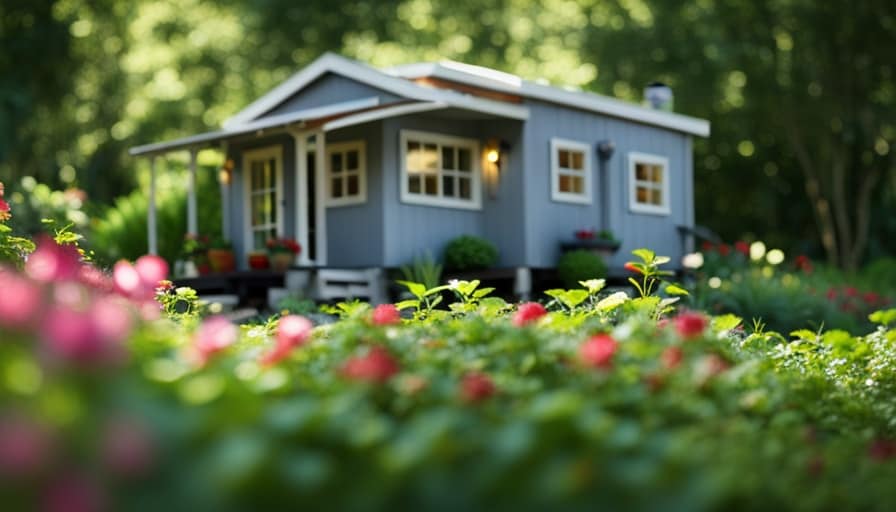
One key aspect to consider is the impact of tiny houses on property values. While some argue that they can decrease property values, others believe that they can actually increase them by adding diversity and uniqueness to the community.
Additionally, one of the challenges I may face is finding legal parking for my tiny house in urban areas. Many cities have restrictions on where tiny houses can be parked, making it essential to find suitable parking options that comply with local regulations.
With these factors in mind, I can now move on to finding suitable land for my tiny house.
Finding Suitable Land for Your Tiny House
After researching the zoning regulations and permitting process, it’s now time to start finding suitable land for my tiny house in Colorado Springs.

When it comes to finding land for a tiny house, there are a few important factors to consider. One of the major challenges is land availability constraints. Due to the increasing popularity of tiny houses, finding land that allows for their construction can be difficult. It’s important to do thorough research and explore different options, such as contacting local real estate agents or checking online platforms that specialize in tiny house-friendly land.
Additionally, environmental impact considerations are crucial. It’s important to choose a location that minimizes the impact on the surrounding environment and aligns with sustainable practices.
Taking these factors into account will ensure that I find a suitable piece of land for my tiny house in Colorado Springs.
Navigating Building Codes and Inspections
When it comes to navigating building codes and inspections for my tiny house in Colorado Springs, I’ll need to familiarize myself with the local regulations and ensure compliance throughout the construction process. Understanding local regulations is crucial to avoid any legal issues and ensure that my tiny house meets all the necessary requirements.

This includes obtaining proper permits, adhering to zoning laws, and following safety guidelines. To ensure a smooth process, I may consider hiring a professional builder who’s well-versed in local building codes and has experience with tiny house construction. Their expertise and knowledge will help me navigate the intricacies of the regulations and ensure that my tiny house is built according to the highest standards.
By understanding the local regulations and working with a professional builder, I can confidently proceed with my project while complying with all necessary codes and inspections.
With the building codes and inspections in mind, the next step is to secure financing and budget for my tiny house project.
Securing Financing and Budgeting for Your Project
To successfully secure financing and budget for my tiny house project in Colorado Springs, I frequently need to research various lenders and explore different funding options. Securing loans for a tiny house can be challenging, as it’s a unique type of project and not all lenders may be familiar with it. However, there are lenders who specialize in providing loans specifically for tiny houses.
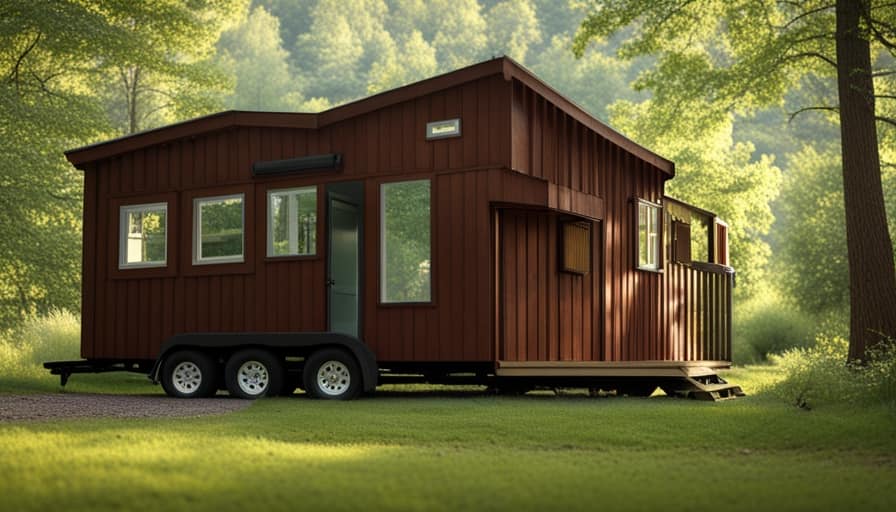
It’s important to gather all the necessary documents and information required by the lenders, such as the cost estimation of the project, including materials, labor, and any additional expenses. By presenting a thorough and well-prepared budget, it increases the chances of securing financing for the project.
Once the financing is secured, it becomes easier to move forward with the next steps of the project, such as dealing with utilities and exploring off-grid options.
Dealing With Utilities and Off-Grid Options
I can explore both traditional utility options and off-grid alternatives when dealing with electricity, water, and sewage in my tiny house in Colorado Springs.
When it comes to off-grid power, there are several options available. Solar panels are a popular choice, harnessing the energy of the sun to generate electricity. Wind turbines can also be used to generate power, particularly in areas with consistent wind patterns. Additionally, hydroelectric power can be harnessed if there’s a suitable water source nearby.

As for water sources, rainwater collection systems can be installed to capture and store rainwater for household use. Digging a well is another option, although it may require permits and additional expenses.
Lastly, composting toilets can be used to manage sewage in an off-grid tiny house, eliminating the need for traditional plumbing systems.
Frequently Asked Questions
What Are the Advantages of Building a Tiny House in Colorado Springs Compared to Other Cities in Colorado?
Building a tiny house in Colorado Springs has many advantages compared to other cities in Colorado. The city has a thriving tiny house community, supportive regulations, and an abundance of natural beauty to enjoy.
Are There Any Specific Design Requirements for Tiny Houses in Colorado Springs?
There are specific design requirements for tiny houses in Colorado Springs, including building regulations that must be followed. It is important to be knowledgeable about these requirements to ensure a successful and compliant build.

How Long Does the Zoning and Permitting Process Usually Take in Colorado Springs?
The zoning and permitting process in Colorado Springs can be a challenge. It takes time to navigate through the requirements and obtain the necessary approvals. However, with proper guidance and patience, it is possible to build a tiny house in Colorado Springs.
Are There Any Restrictions on Living in a Tiny House on Wheels in Colorado Springs?
Living in a tiny house on wheels in Colorado Springs comes with restrictions. Tiny house parking options are limited, and building codes for tiny houses must be followed. It can be challenging, but not impossible.
Can I Rent Out My Tiny House as an Airbnb in Colorado Springs?
Renting out a tiny house as an Airbnb in Colorado Springs is possible, but there are regulations to follow. It’s important to familiarize yourself with local zoning laws and obtain any necessary permits before listing your tiny house as a rental property.
Conclusion
Building a tiny house in Colorado Springs may be challenging due to zoning regulations, finding suitable land, navigating building codes, securing financing, and dealing with utilities.
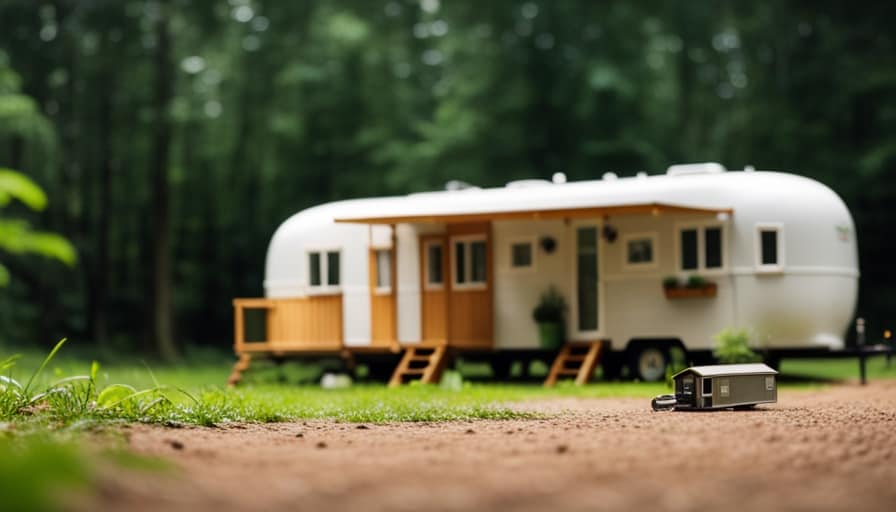
However, with determination and thorough research, it’s possible to overcome these obstacles.
For example, Sarah, a Colorado Springs resident, successfully built her own off-grid tiny house by carefully selecting land outside city limits, obtaining the necessary permits, and utilizing solar power.
Her experience demonstrates that with proper planning and knowledge, building a tiny house in Colorado Springs can be a rewarding and sustainable endeavor.
I’m Theodore, and I love tiny houses. In fact, I’m the author of Tiny House 43, a book about tiny houses that are also tree houses. I think they’re magical places where imaginations can run wild and adventures are just waiting to happen.
While tree houses are often associated with childhood, they can be the perfect adult retreat. They offer a cozy space to relax and unwind, surrounded by nature. And since they’re typically built on stilts or raised platforms, they offer stunning views that traditional homes simply can’t match.
If you’re looking for a unique and romantic getaway, a tree house tiny house might just be the perfect option.
-

 Beginners Guides2 weeks ago
Beginners Guides2 weeks agoHow To Buy A Tesla Tiny House
-

 Energy Efficiency2 months ago
Energy Efficiency2 months agoBest Tiny Homes For Cold Climates
-

 Beginners Guides1 week ago
Beginners Guides1 week agoTiny House Nation Where Are They Now Stephanie
-

 Tiny House Resources (e.g., legalities, cost, insurance, FAQs)2 months ago
Tiny House Resources (e.g., legalities, cost, insurance, FAQs)2 months agoDo Tiny Homes Need Planning Permission?
-

 Beginners Guides3 weeks ago
Beginners Guides3 weeks agoFrom The Show Tiny House Nation How Many Keep Their Tiny House?
-

 Beginners Guides2 months ago
Beginners Guides2 months agoUsing a Climbing Net For Treehouse Construction
-

 Beginners Guides2 months ago
Beginners Guides2 months agoHow to Build a Treehouse Without Drilling Into the Tree
-

 Beginners Guides3 weeks ago
Beginners Guides3 weeks agoTiny House Nation Who Pays For The Houses





